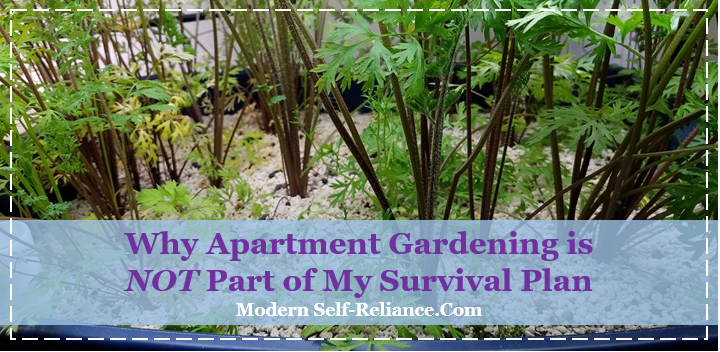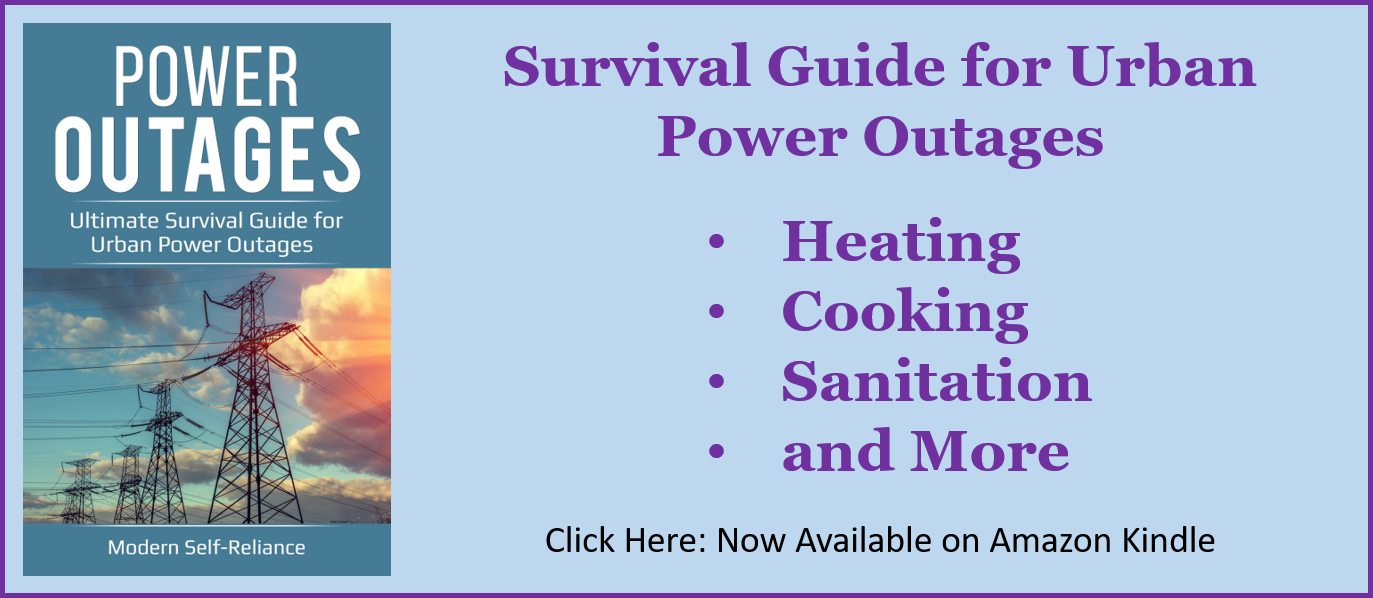I have the ability to grow plants in my apartment. I have detailed my indoor apartment growing system which I have used to successfully grow carrots, tomatoes, green beans, spinach, and jalapenos. (My Indoor Growing Systems) Growing inside allows you to grow through the winter and have fresh produce year round. However there are a few reasons, that I don't consider this indoor garden part of my survival plan. If SHTF I won't be surviving off this garden.
Quick overview of my growing system: I have 2 six-foot racks that enable me to have twelve 13-gallon buckets of dirt. I typically use self-watering bins that can hold 1 gallon of water in the base. I have several T5 grow lights on timers and a fan. To see pictures take a look here: Construction Guide to Indoor Growing Systems.
#1 Apartment Growing has Limited Square-footage
At max capacity I can grow with all 12 bins. Each bin is 12"x 14" approximately, which gives me a whole 14 squarefeet of growing space! Let do some math like the Martian and science this out. If I grow only potatoes:
- 12 potatoes plants
- Estimated yield 5 pounds of potatoes per plant
- 60 pounds of potatoes per harvest
- Seed to harvest: 17 weeks
- 3 harvests a year
- 180 pounds of potatoes a year
- 347 calories per pound of potato
- 62,460 calories a year
Now I have ~62K calories to ration as I need from my potato crop, or to supplement my normal supplies.
- 1500 calories a day = 41.6 days
- Entire diet of potatoes
- 1000 calories a day = 62.4 days
- 2/3 diet of potatoes
- 500 calories a day = 124.9 days
- 1/3 diet of potatoes
If I look at it another way, I have produced 171 calories of potato energy per day over the course of the year. If you really want to get scientific about this you will then have to calculate the calories you burned while planting, watering, checking on the plants, and harvesting. The calculated calories are for one person, as soon as you add spouses and children you can see it is just not feasible to grow enough potatoes.
#2 Apartment Growing has Massive Electric Needs
While running both racks I used approximately 200 kWh of electricity in a month. Since my apartment doesn't get any direct sunlight through the windows (poor urban planning), my plant rely on the high output lights for their energy. This means I need 6-7 kWh (7000 Wh) of electricity a day to keep the plants running. It's hard to imagine this amount of energy needed, since we can't hold a kiloWattHour of electricity in our hands.
Lets take a look if I decided to use solar to power my lights, and fan. This is highly inefficient since I am taking solar energy, turning it into electric energy, then using electricity to produce solar energy for the plants.
Consider this ~4 foot by 2 foot solar panel: Renogy 100 Watt 12 Volts Monocrystalline Solar Panel
- It costs ~$134
- It can produce 500 Watt-Hours during peak performance (direct sun)
- Need 14 panels to power my T5 grow lights
- 14 panels would cost $1,876
- Need 112 square-feet to put the panels
I think the apartment complex would frown on me covering their roof with solar panels. While this may be feasible for a house, it is not feasible in my apartment. Also as stated above, my apartment gets no direct sun, so solar panels mounted in the windows won't provide adequate light. Otherwise I would just grow my plants in the window.
If there is no electricity because the grid is down I am out of luck. If I am tight on cash, these lights doubled my electric bill from ~$50 a month to $100 a month. Which all depends on your electric rates. Either way, this is lots of energy to be pumping into a system.
#3 Apartment Growing has Massive Heating Needs
My tender potato plants need to be warm. While the plants can survive beyond their comfort zone (40-80 degrees F), I am looking for peak output so I need peak temperature. Potatoes are grown in the summer and harvested before it becomes too hot in late summer (+85 deg F). So my apartment should be kept at an optimal 70-75 degrees F to benefit the plants.
Most people, aside from nursing homes, don't keep their homes 75 degrees. The heating costs are prohibitive, especially when to below 0 degrees F outside in the middle of winter. I won't estimate the heating costs, as they vary widely by the given heating system.
In a survival situation when the grid is down or funds are tight, it will be difficult to keep the apartment at a warm enough temperature to optimally grow potatoes. Anything less than optimal temperatures will reduce the yields and reduce the calories produced.
Conclusion
Gardening inside an apartment is just not feasible in a survival situation. You can't grow enough calories, and the heating/lighting needs would be significant. Gardening outside when nature provides light and heat are going to be a better option. Gardening in a greenhouse or hoop house during the spring and fall may provide between options to extend the growing season. Overall, I know I won't be relying on my indoor growing system for providing my caloric needs.
Do you have an indoor growing methods that could come closer to providing for your caloric needs? Share your system in the comments below.
Read more:
- Construction Guide to Indoor Growing Systems
- 7 Actually Easy to Grow Vegetables for New Gardeners
- 8 Steps to Evaluating your Food Preparedness for Power Outages


